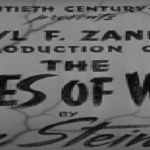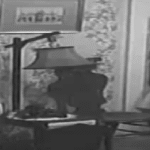The Amazing Mr. X, also known as The Spiritualist, is a 1948 American film noir infused with supernatural elements, directed by Bernard Vorhaus and starring Turhan Bey, Lynn Bari and Cathy O’Donnell. A moody, atmospheric thriller, it explores themes of grief, manipulation and illusion, set against a haunting, coastal backdrop. The film is distinguished by its cinematography, courtesy of the renowned John Alton, whose mastery of light and shadow creates an eerie, almost dreamlike quality throughout.
The story opens on a lonely beach at twilight. Christine Faber, a wealthy and recently widowed woman, is seen wandering by the sea, mourning the loss of her husband, Paul, who died two years earlier in a tragic accident. Though she is engaged to be married to Martin Abbott, a steadfast and pragmatic man, Christine remains emotionally tethered to her deceased husband. Her solitude is broken when she hears a mysterious voice calling her name from the darkness, and she sees a shadowy figure on the cliffs above. Startled and unsettled, she returns home, unsure whether what she experienced was real or the product of her imagination.
Soon after, Christine encounters a man named Alexis, played with suave charm and subtle menace by Turhan Bey. Alexis introduces himself as a spiritualist, someone who can communicate with the dead. He seems to know intimate details about her life, including the death of her husband and her innermost thoughts. Christine, desperate for answers and increasingly convinced of the paranormal, finds herself drawn to Alexis. Despite her initial scepticism, his apparent insights into her past and his persuasive demeanour weaken her resolve. She begins attending séances, seeking comfort in the idea that Paul might still be with her in some ethereal form.
Alexis, however, is not what he appears to be. Beneath the façade of mysticism lies a cunning conman, a master manipulator skilled in the art of illusion and psychological control. Using a network of accomplices and clever stagecraft, he preys upon the vulnerable, exploiting their grief for personal gain. What sets Alexis apart from a common fraudster is his almost hypnotic presence – he believes in the power of his own performance, blurring the line between deception and belief.
Christine’s younger sister, Janet, played by Cathy O’Donnell, is far more sceptical. Protective of Christine and suspicious of Alexis, she begins to investigate him. She enlists the help of Martin, Christine’s fiancé, and the two slowly unravel the spiritualist’s schemes. As Janet delves deeper, she uncovers the elaborate tricks Alexis employs – hidden microphones, secret passageways, and cleverly rigged effects that mimic supernatural occurrences. Their suspicions are confirmed, but they soon discover that Alexis is entangled in a much darker plot than mere fraud.
The twist arrives when it is revealed that Christine’s husband Paul is not, in fact, dead. Played by Donald Curtis, Paul faked his own death in order to escape the consequences of his criminal activities. He has returned to blackmail Alexis into helping him regain control over Christine’s wealth. The revelation recontextualises the earlier hauntings – the voice on the beach, the ghostly appearances – as part of a broader conspiracy orchestrated by Paul, with Alexis as an unwilling accomplice.
This development shifts the narrative from a ghost story to a noir-inflected tale of coercion and guilt. Alexis, despite his manipulative nature, is shown to be conflicted. He is not the architect of Paul’s deception but rather its pawn, threatened and forced into compliance. His internal struggle adds a layer of moral ambiguity – he is both a deceiver and a victim, a man who has gone too far to turn back, yet not beyond redemption.
As Paul’s demands become more dangerous, Alexis begins to resist. His feelings for Christine, though initially feigned, may not be entirely false. In a moment of conscience, he warns her of the danger she faces, but before she can fully act, events spiral out of control. Paul’s violent tendencies resurface, and a climactic confrontation ensues.
The final act is marked by suspense and visual intensity. Christine, now aware of the full extent of the deception, must confront both the literal and emotional ghosts of her past. Alexis sacrifices himself to protect her, confronting Paul in a final showdown that results in Paul’s death and Alexis’s arrest. Despite his role in the earlier deceit, Alexis’s ultimate act is one of redemption – he chooses truth and protection over manipulation.
Christine is left to pick up the pieces of her life. Though deeply shaken, she gains a sense of closure – the man she mourned is gone not in spirit, but in reality, unworthy of the love she once held for him. In shedding the illusion, she finds a path forward, grounded not in false hope but in emotional honesty. Martin remains by her side, offering stability and compassion.
From a technical perspective, The Amazing Mr. X is a masterclass in atmospheric cinematography. John Alton’s use of light and shadow creates a pervasive sense of unease. The crashing waves, misty cliffs, and dimly lit interiors evoke a gothic sensibility, while the visual contrasts – between light and dark, truth and illusion – mirror the film’s thematic concerns. The music, composed by Alexander Laszlo, complements the visuals, weaving tension and melancholy into the narrative.
Though the film did not receive major critical acclaim upon its release, it has since gained recognition as a cult classic. Its blend of noir, psychological drama and supernatural suggestion sets it apart from conventional mystery thrillers of the era. The character of Alexis, in particular, is notable for his complexity – neither fully villain nor hero, he represents the grey area between manipulation and morality.
The Amazing Mr. X also serves as a reflection on grief and vulnerability. Christine’s desire to believe in the afterlife, to reconnect with a lost love, makes her susceptible to deception, yet her journey is not one of foolishness but of human frailty. The film suggests that the greatest illusions are not those conjured by spiritualists, but those we create for ourselves in the search for comfort.
The Amazing Mr. X is a haunting and visually rich film that blends genres to explore the nature of deception, redemption and emotional recovery. Through its twisting plot, evocative imagery and morally ambiguous characters, it presents a compelling story that lingers long after the final scene. Far more than a standard mystery, it is a nuanced portrait of loss, belief and the power of truth to dispel even the most seductive illusions.







